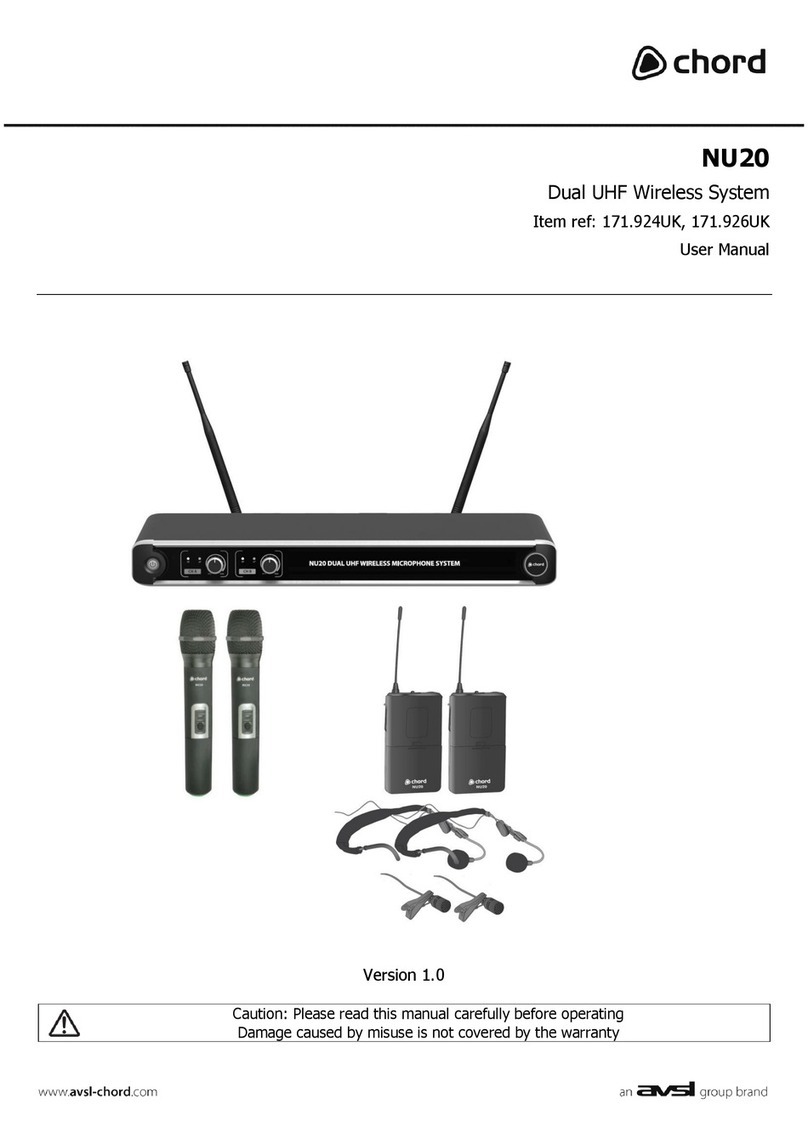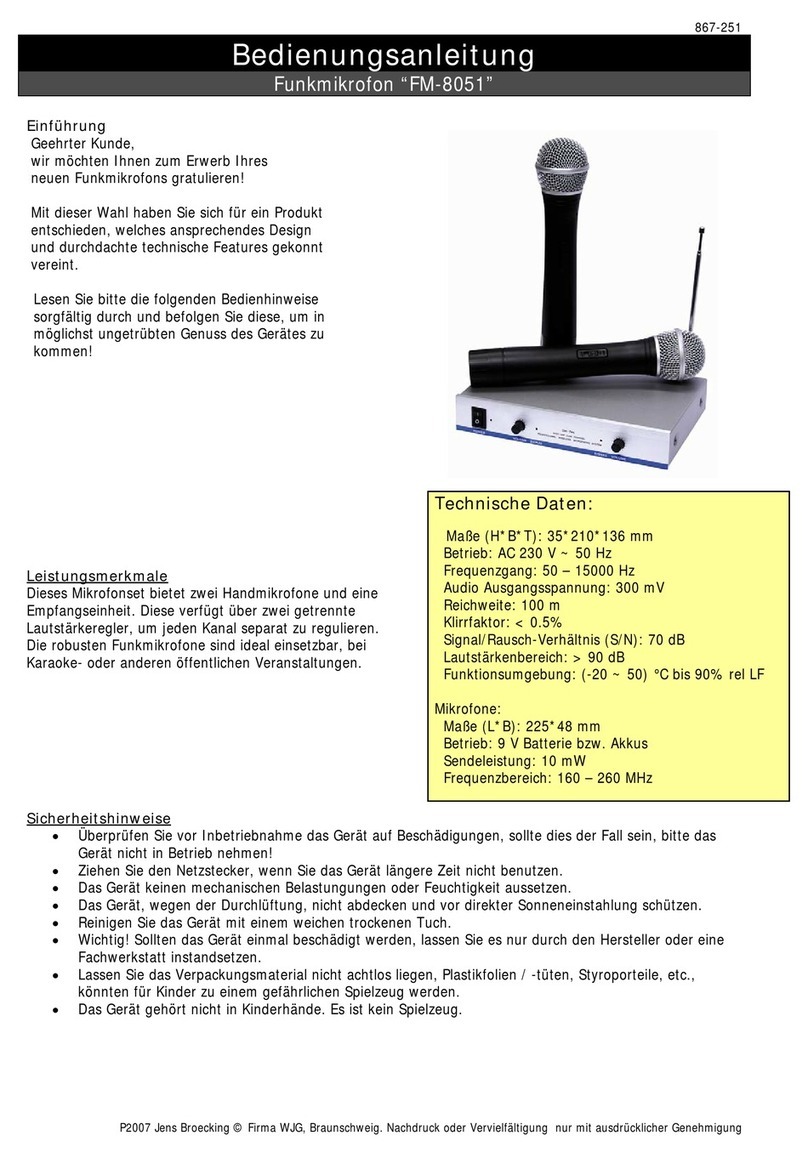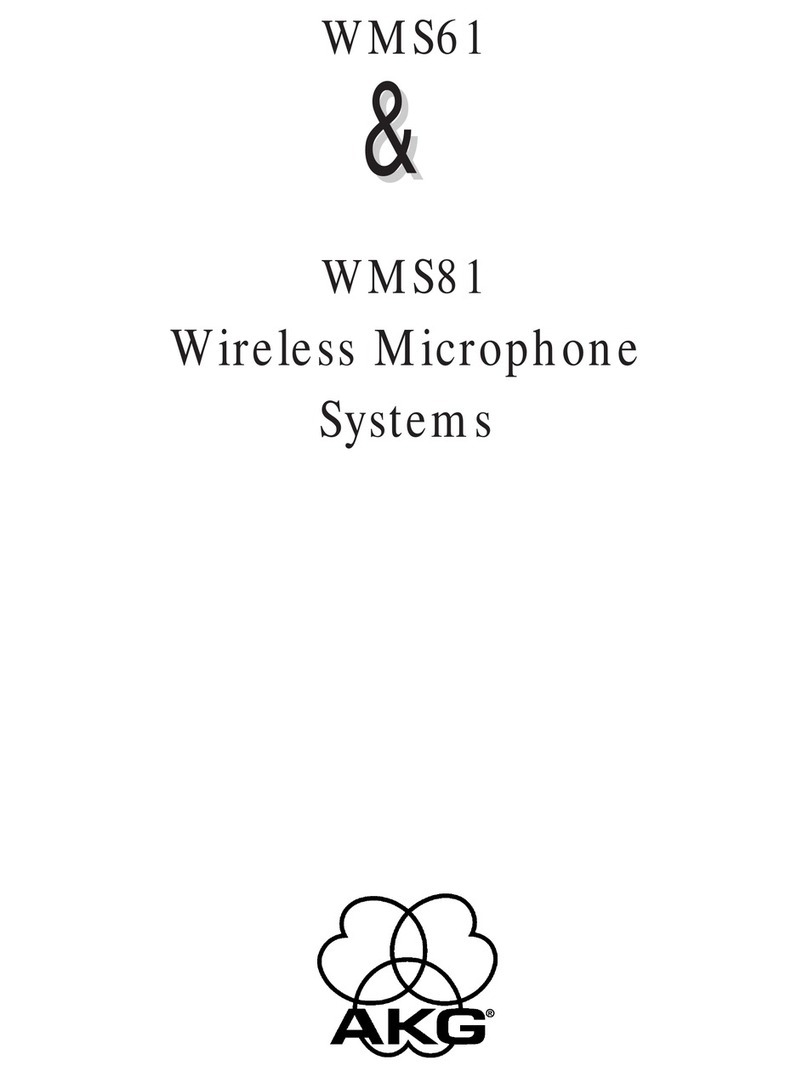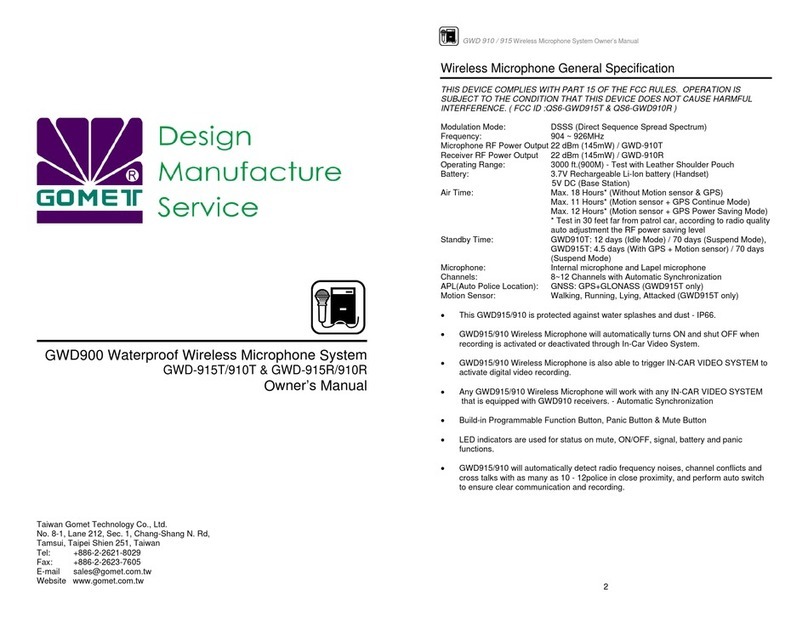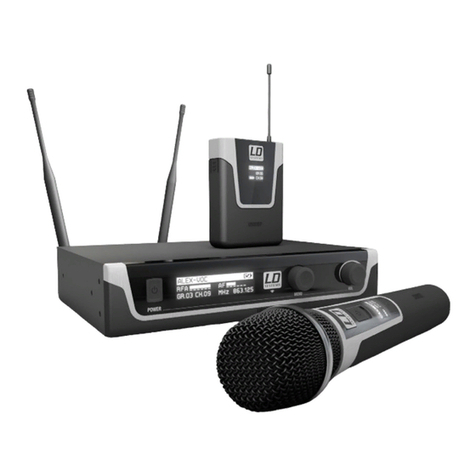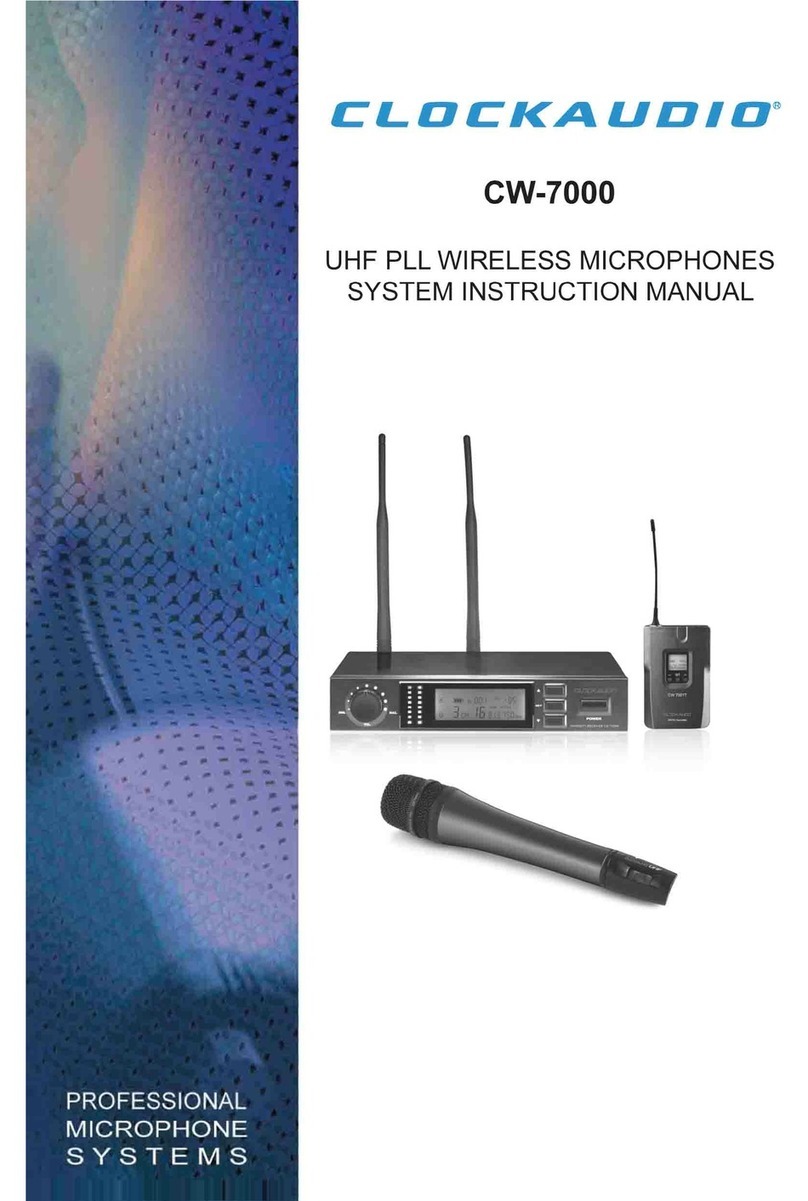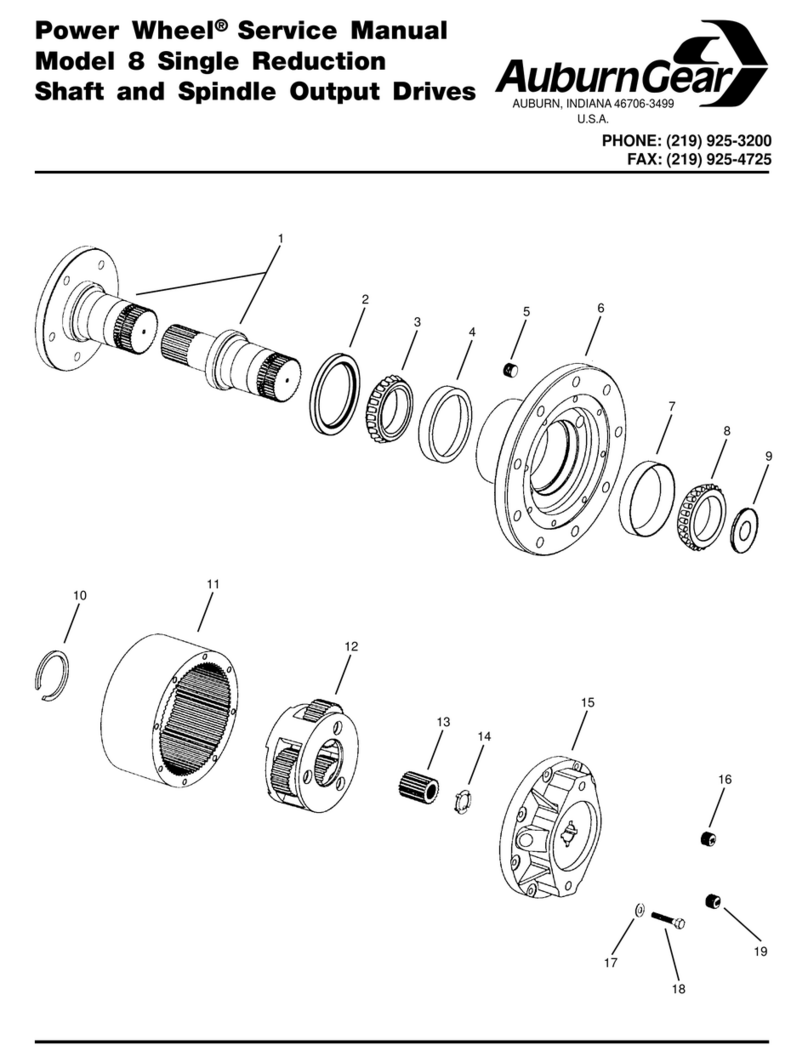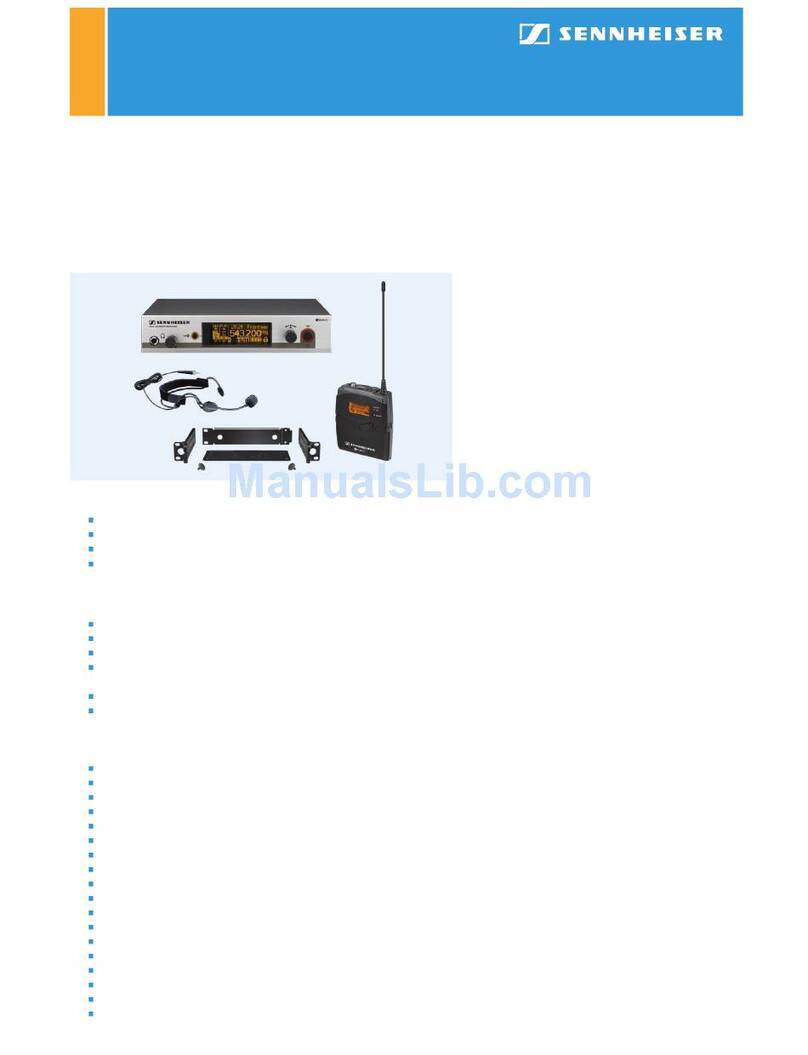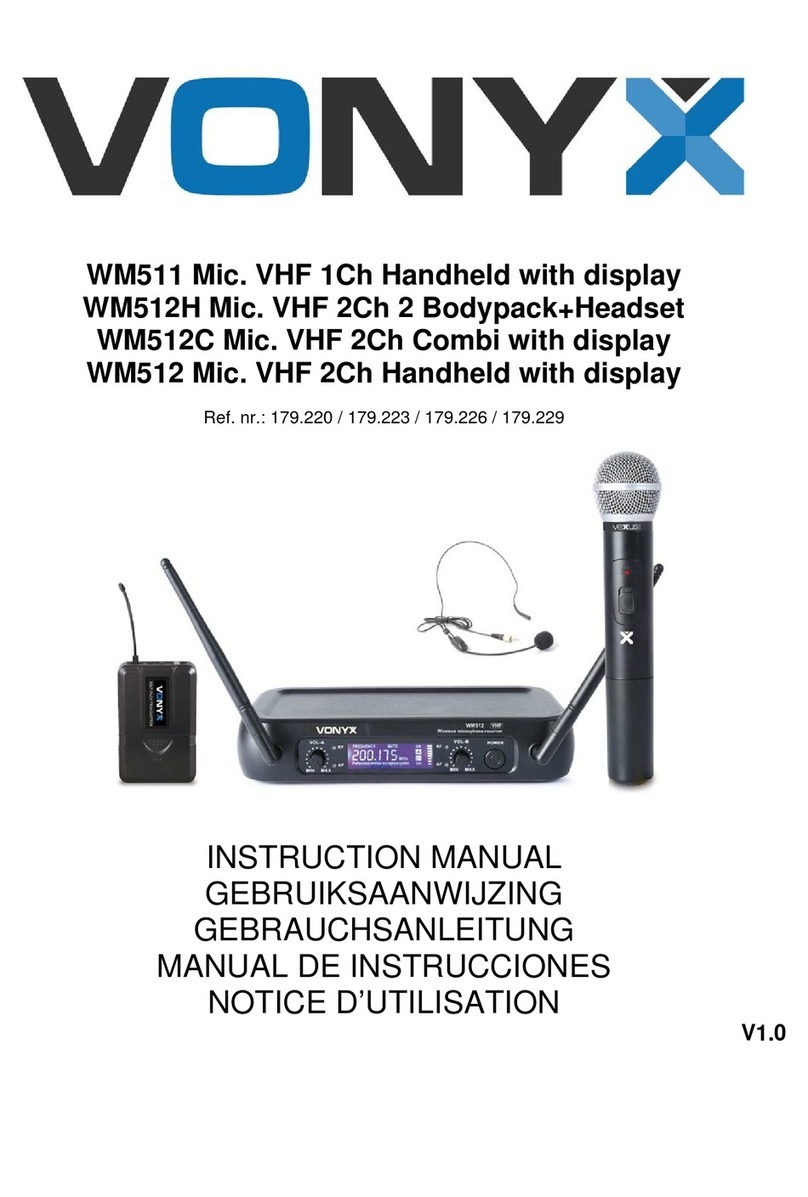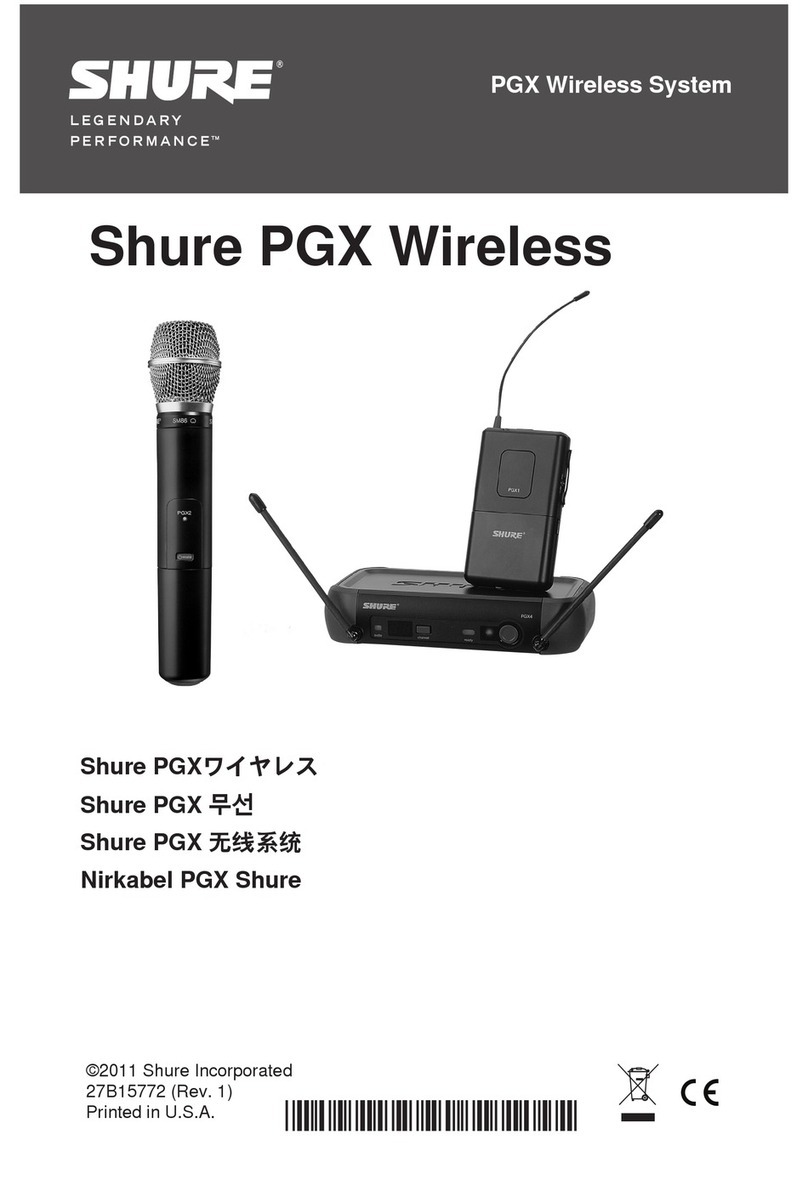FCS XMIC User manual

XMIC ®
XMIC User Manual
Fluid Conservation Systems, Inc
502 TechneCenter Drive, Suite B
Milford, Ohio 45150
Phone (800) 531-5465
www.fluidconservation.com

Xmic 24/01/05
MAN-095-0001 Revision B © Palmer Environmental Ltd 2005
Page 1
Contents
Xmic Introduction 2
Warnings 3
System Description 4
Optional Additional Equipment 5
Xmic Overview 6
Preparing the Xmic for Use 8
Using the Xmic 9
Filter Selection 10
Survey Mode 10
Survey Mode Screens 11
MLP Mode 15
MLP Mode Screens 16
Guidance to Effective Acoustic Leak Detection 17
Xmic Technical Specification 20
Warranty 22

Xmic 24/01/05
MAN-095-0001 Revision B © Palmer Environmental Ltd 2005
Page 2
Introduction
The Xmic is an advanced, electronic ground microphone designed to amplify the
noise generated by water escaping from buried supply pipes under pressure. By
means of identifying the position of the loudest leak noise indicates the position
of the actual leak itself.
The Xmic system comprises a lightweight portable amplifier module complete
with battery charger, a pair of aviation-quality headphones and an acoustically
shielded ground microphone foot. As an optional extra, a hand-held listening
probe is available. This comes with a tripod foot and two probe rods for sounding
in soft ground.
The portable amplifier module has an LCD display and the advanced, easy-to-use
features of the Xmic enable the operator to pinpoint leaks faster and with more
confidence than ever before.
Note: The headphones supplied with the Xmic cannot be interchanged. The
impedance of the headphones is matched to the Xmic control unit during
manufacture.
Key features
• Sliding scale filter selection
• Backlit multi-function LCD display showing:
•Noise level graphically and digitally
•Dynamic sensitivity (signal strength)
•Settings and operation mode
• Levels of leak noise can be recorded for comparison in a histogram profile (MLP)
• IP65 enclosure
• Aviation-quality headphones with volume control
• Lightweight, easily portable system
• Membrane keypad
• Versatile – ground microphone and hand probe configurations
• Military specification connectors
• Robust construction for field use
• Rechargeable batteries (up to 25 hours use)

Xmic 24/01/05
MAN-095-0001 Revision B © Palmer Environmental Ltd 2005
Page 3
Warnings
Lithium ion batteries
The batteries supplied and fitted to the Xmic units are rechargeable lithium ion.
Do not short circuit or overcharge these batteries. Any misuse of these batteries
may result in explosion or fire. They must not be used in any other application or
used with any other equipment. Only batteries supplied by Palmer Environmental
must be used.
Microphone foot warning
The Microphone foot has a sensor attached that can be seen from the bottom of
the unit. Users must not attempt to unscrew this sensor as this will break internal
components of the microphone resulting in irreparable internal damage.
Sensor replacement is then the only option.
Any necessary repair or dismantling of the foot must be carried out by Palmer
Environmental or by an authorised distributor.
If the sensor does become loose it should be tightened manually so that it is
“finger tight". Excessive force will cause damage.
Sensor: Do NOT attempt to unscrew

Xmic 24/01/05
MAN-095-0001 Revision B © Palmer Environmental Ltd 2005
Page 4
System Description
Control unit – robust for field conditions
The control unit is the operator interface. It is very easily portable, and can be
carried by either hand or shoulder-strap. Its injection-moulded housing is purpose-
designed to provide long-term field durability and effective protection under realistic
site conditions and is environmentally rated to IP65.
The control unit has a membrane keypad, with push-key operation, and a backlit
multifunction LCD display. The interface to the headphones, charger and microphone
are via military-specification connectors.
Versatile leak noise sensing
The acoustically shielded ground microphone foot provides isolation from airborne
noise interference and can therefore be used in wet and windy conditions.
Standard equipment list:-
1. Control/amplifier module with adjustable
carry strap.
2. Acoustically shielded ground microphone
foot.
3. Aviation quality headphones.
4. Lithium ion battery pack and battery charger.
5. Carry case.
6. Cables.
7. Manual.

Xmic 24/01/05
MAN-095-0001 Revision B © Palmer Environmental Ltd 2005
Page 5
Optional Additional Equipment
A handheld sensor unit can be added to the system as an option, providing the
operator with the facility to use this as a smaller ground microphone with its tripod;
or to use it with probe rods to sound fittings in deep chambers or to use in soft
ground.
Equipment list including optional extras:-
1. Control/amplifier module with adjustable carry strap.
2. Combined hand probe and ground microphone with integral cable.
3. Two 400mm stainless steel rods.
4. One short legged tripod.
5. Aviation quality headphones.
6. Lithium ion battery pack and charger.
7. Carry case.
8. Cables.
9. Manual.
Xmic with optional handprobe,
tripod and probe rods.

Xmic 24/01/05
MAN-095-0001 Revision B © Palmer Environmental Ltd 2005
Page 6
Xmic Overview
Number Description
1Mute Button
2Mode Select
3Dynamic Acoustic Signal Level meter
4Battery Status
5Power On/Off and Back Light
6Gain Level
7Gain Increase/Decrease
8Battery Charging LED
9Contrast Adjustment
10 Context Sensitive Button
11 Context Sensitive Button
12 Context Sensitive Button

Xmic 24/01/05
MAN-095-0001 Revision B © Palmer Environmental Ltd 2005
Page 7
Number Description
1Headphone and Charger Socket
2Sensor Socket
3Retaining Screws for Battery Compartment

Xmic 24/01/05
MAN-095-0001 Revision B © Palmer Environmental Ltd 2005
Page 8
Preparing the Xmic for Use
The battery pack for the Xmic is supplied as a separate item in the carry case. The
batteries within this pack are supplied quarter charged. To insert the battery pack,
unscrew the three screws on the underside of the unit, remove the cover and
packing foam and connect the battery pack. Place in the battery compartment, refit
the packing foam and then replace the cover with the three screws.
Battery charging
To charge the batteries, connect the charge lead from the charger to the
headphones/battery charge connector on the back of the Xmic. Plug the charger unit
into the mains supply.
While the batteries are charging, the charging LED will be illuminated. This only goes
out when the batteries are fully charged. The Xmic unit cannot be used while the
batteries are charging. However, it can be turned on, a sensor can be plugged in and
a meter reading will be given, but there will be no sound as the headphones are not
connected during battery charging. The time required to charge the batteries from
flat is approximately 7 hours.
The On/Off switch can be pressed while the unit is on charge to see how much
charge is in the batteries at any time, however, the Xmic MUST be switched back off
again in order to resume charging. When fully charged the battery icon will appear
completely dark.
Battery replacement
Although the batteries are rechargeable, they may eventually need to be replaced.
Only batteries configured to the correct specification and type must be used, these
are available from Palmer Environmental.
To replace the batteries switch the unit off, unscrew the three screws on the
underside of the unit. Remove the packing foam then unplug the battery connector
and remove battery pack. Connect the new battery pack, refit the packing foam then
replace the cover using the three screws.

Xmic 24/01/05
MAN-095-0001 Revision B © Palmer Environmental Ltd 2005
Page 9
Using the Xmic
Select the sensor attachment required, either the acoustically shielded ground
microphone foot, or the optional microphone unit with probe rods or tripod which
must be screwed into the bottom of the microphone housing. Plug the headphones
into the Xmic control unit.
Xmic Switch On/Off
Switch the unit on by momentarily pressing the On/Off switch. The unit will switch on
and remain switched on until this same button is pressed again unless it is left
unused. To switch the unit off, the On/off switch must be pressed and held down for
3 seconds.
Headphones mute
To switch the headphones on press the headphones button. To switch them off press
the same button again. The headphones mute icon will be displayed. Note there is a
rotary control on the headphones to adjust the volume. To momentarily mute the
headphones, press and hold the mute button.
Back Light
To view the LCD display in bad light, illuminate the backlight by pressing the
combined On/Off Backlight switch briefly. To switch it off, press this same button
momentarily.

Xmic 24/01/05
MAN-095-0001 Revision B © Palmer Environmental Ltd 2005
Page 10
Filter Selection
To clarify the leak noise, background or unwanted noise frequencies can be filtered
out using a combination of the controls on the Xmic. Unwanted frequencies can be
filtered out via the bandpass, bandwidth and filter position buttons.
There are two modes of operation – survey mode and minimum level profiling mode
(MLP)
Survey Mode
In survey mode, the gain level can be adjusted for optimum volume and the filters
can be adjusted to reduce unwanted ambient noise. To locate the position of an
underground leak the microphone foot is placed on the ground above the line of the
suspect pipe and the readings observed.

Xmic 24/01/05
MAN-095-0001 Revision B © Palmer Environmental Ltd 2005
Page 11
Survey Mode Screens
Preset Filter Screen
This is the initial screen, which
appears when the Xmic is
switched on.
Adjustable Filter Screen
Pressing the Mode Select
button (red button on left-
hand side of screen) once will
bring the user to the opposite
screen where they can enter
their own custom filters.

Xmic 24/01/05
MAN-095-0001 Revision B © Palmer Environmental Ltd 2005
Page 12
Unfiltered Noise
This is the default screen showing
no filters have been applied.
Frequency spectrum indicator
bar shows that all frequencies
are available
Preset Filter for High Frequencies
Used on metal pipes.
The frequency spectrum indicator bar
shows only the higher frequencies are
allowed through when the high pass
filter button is pressed

Xmic 24/01/05
MAN-095-0001 Revision B © Palmer Environmental Ltd 2005
Page 13
Preset Filter for High and Medium
Frequencies
Used on plastic (MDPE) pipes.
The frequency spectrum indicator bar
shows both medium and higher
frequencies are allowed through. Low
frequencies are filtered out.
Adjustable Filters - Bandwidth
Pressing the Mode Select button
(red button on left-hand side of
screen) once will bring the user to
the opposite screen where he/she
may enter their own filters
according to the job in hand.
The bandwidth of the frequencies
allowed through can be adjusted
using the double-headed arrow
buttons as shown here.

Xmic 24/01/05
MAN-095-0001 Revision B © Palmer Environmental Ltd 2005
Page 14
Adjustable Filters - Bandpass
To access this screen press the
second button from the left
(bottom row) whilst in the
adjustable filters screen (see
previous page)
Pressing this button again will
revert to the previous screen
The position of the bandpass
frequencies can be adjusted up or
down the spectrum using the left
and right arrows

Xmic 24/01/05
MAN-095-0001 Revision B © Palmer Environmental Ltd 2005
Page 15
MLP Mode
MLP stands for Minimum Level Profiling. This is performed by stepping along the line
of the suspect pipe and recording the sound levels. The ground microphone is placed
on the ground and the sample button pressed momentarily. The Xmic then records
the minimum noise over three seconds.
As each recording is made the histogram graph is built up showing the difference
between each reading visually and numerically making noise level comparison a
simple task.
For each sample taken a number appears on the top right of the screen. This noise
level value is a relative indicator for each sample. Once several readings have been
taken the operator can select a sample by pressing the + or - button on the right of
the Xmic. The numerical noise level value is then shown for each sample.

Xmic 24/01/05
MAN-095-0001 Revision B © Palmer Environmental Ltd 2005
Page 16
MLP Mode Screens
Once filters have been selected go to the MLP (Minimum Level Profiling) screen by
pressing the Mode Select button, to carry out a leak noise comparison.
Each time this button is pressed momentarily the leak noise aquired in the previous
three seconds is recorded and displayed as a vertical bar on a histogram. In the
example above, eight consecutive readings have been taken by stepping the ground
microphone along the length of the pipe and pressing the sample button at each
position.
Press the Mode Select button to display the
MLP screen.
The frequency spectrum indicator bar
shows the filter bandwidth setting
To record the leak noise sound (graphically)
at different positions, press here.
Each time a sample is taken, a relative
number appears on the right of the
screen.
Each sample can be subsequently
selected to check the relative number by
pressing the + or – buttons on the right
side of the screen.
This indicates the greatest leak noise
acquired and the probable position of the
leak.

Xmic 24/01/05
MAN-095-0001 Revision B © Palmer Environmental Ltd 2005
Page 17
Guidance to Effective Acoustic Leak Detection
All acoustic leak detection methods are based on the premise that normal water
passage through pipelines takes place noiselessly. When the water passage is
disturbed a noise is created. Causes can include partial pipe blockages, sudden
changes in pipe diameter, abrupt changes in pipe direction, pumps or meters
installed in the pipeline, consumer usage or pipeline damage. Pipeline damage can
include holes, cracks or splits, complete pipeline rupture, leaking joints or leaking
valves.
Careful application of leak detection techniques will enable the operator to eliminate
detected noises generated by poor pipeline design or consumer usage and to identify
leakage due to pipe system damage.
The strength and clarity of noise generated by leaks will be affected by the water
pressure, the size and shape of the orifice allowing leakage, the type of ground
material around the pipeline, the type of ground cover over the pipe, the diameter,
wall thickness and material of the pipeline and the quantity of water leaking.
A small orifice or hole and high water pressure generally produces a higher
frequency noise. Often the noise level increases around valves, pipe elbows, T-
connections and pipe ends, etc… since the partial obstruction increases pressure and
creates some further disturbance in the water path.
Leak noise is transmitted along the pipeline both through the water and the pipe wall
as well as into the ground around the pipe. The noise travels much better through
"hard" materials: further along metallic pipes than asbestos cement pipes which
themselves are better than plastic pipes. Ground material generally provides a
poorer travel path than the pipeline itself. Soft sandy ground provides a worse travel
path than well compacted ground with a hard paved surface covering.
The leak noise can change in strength and pitch as it travels along the pipe or
through the ground. The deeper the pipe is buried and the softer the ground the
more the noise will be dampened.
When a leak is produced in a metallic pipe the leak noise will transmit well through
the pipe. It does not travel so well through a plastic pipe. This means that a leak

Xmic 24/01/05
MAN-095-0001 Revision B © Palmer Environmental Ltd 2005
Page 18
noise can be heard further away on metal than on plastic. Also bear in mind that the
further you go from a leak noise source the more difficult it is to pinpoint that leak
noise accurately.
Background noise can interfere with leak detection. Traffic and machinery noises can
travel for considerable distances through both air and ground material and often
occur in the same frequency bands as leak noise. Sometimes it is necessary to use
leak detection techniques at night when interfering noises are less.
It is very important to adopt a methodical approach when using any instrument for
acoustic leak detection. It is necessary to practice the technique in order to
distinguish between different sounds, recognising background or interfering noises,
so that they can be eliminated. It is also essential that other (non-leakage) system
noise sources such as consumer draw-off or partially closed valves be eliminated by
logical site inspection practices prior to any excavation taking place.
Hand probe
For normal soft ground surfaces the single pointed extension rod should be
connected - do not over-tighten the screw thread. For direct contact with
underground fittings via access covers it may be necessary to use the second
extension rod. To do this, remove the single rod and connect the extension rod -
replacing the pointed rod again. If the rods have been over-tightened, spanner slots
allow easy removal.
Surveying
The leak location can be narrowed down by listening at accessible contact points
such as meters, hydrants, valves and stop-taps. These provide good points of sound
pick-up, particularly if the pipe is metallic. Use the hand-probe/extension rod to
listen at these points.
If there are no accessible contact points or if the pipe is of non-metallic material, use
the microphone foot for listening, placing the foot over the pipe route in the area of
the suspected leak. Move along the pipe route listening at each accessible pipefitting

Xmic 24/01/05
MAN-095-0001 Revision B © Palmer Environmental Ltd 2005
Page 19
or at regular positions on the ground until you have identified the area of maximum
noise level.
Note: When you are listening on pipe-fittings the location of the point of maximum
noise will probably not indicate the leak position, only the fitting closest to the leak.
The noise level will also appear stronger where there is less thickness of ground or
other material for it to pass through. The leak noise will follow the path of least
resistance.
Pinpointing the leak position
Pinpointing the leak position involves a process of comparing a number of leak
noises. Select the most suitable sensor device; the microphone foot for hard ground
surfaces or the hand probe for soft ground.
Operate the ground microphone and adjust the headphone volume control to a
comfortable listening level. Once you have listened to the noise through the
headphones, mute the headphones and move the microphone foot or hand probe to
the next test position.
Repeat the sequence to listen to each of the test locations moving along the pipe
route in the direction where signal strength is increasing. If the leak noise level falls
you have passed the leak and should go back and reduce the distance that you move
between measurements. The loudest leak noise will then indicate the location of the
leak bearing in mind the ground conditions already mentioned.
Table of contents
Popular Microphone System manuals by other brands

Omnitronic
Omnitronic WM-224 user manual
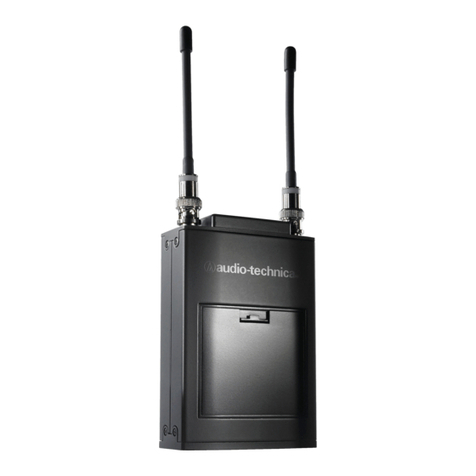
Audio Technica
Audio Technica 1800 Series Setup and operation manual
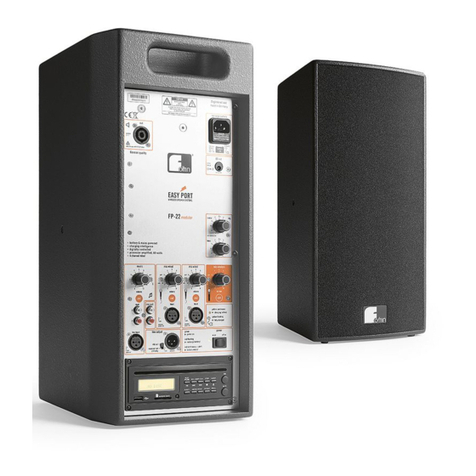
Fohhn
Fohhn Easy Port Series User instructions
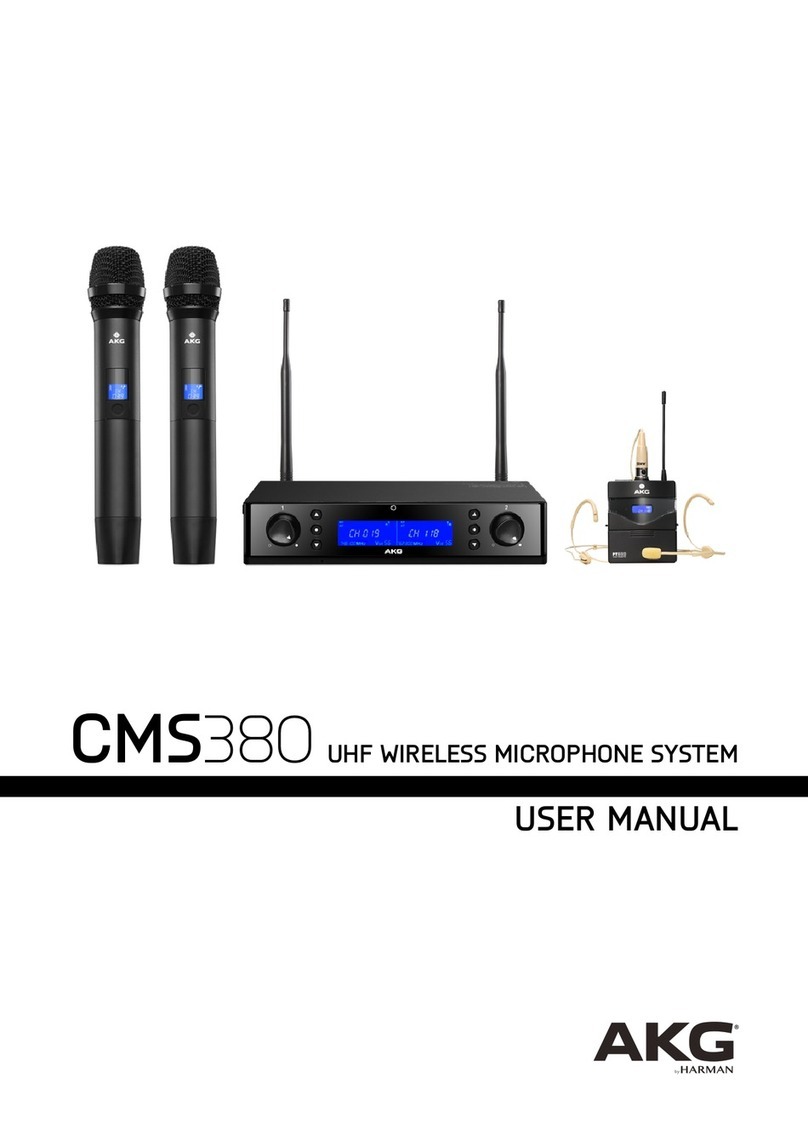
Harman
Harman AKG CMS380 user manual
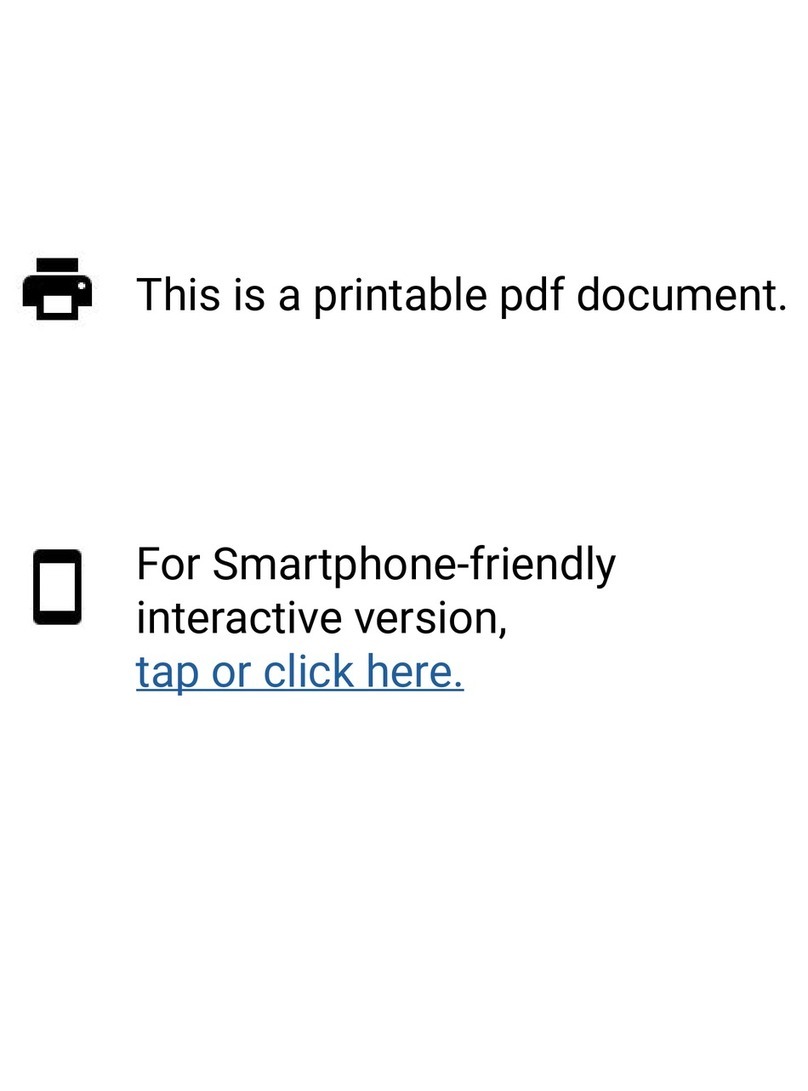
Schlage
Schlage NDE80 Installation instructions and user guide

Sennheiser
Sennheiser EW 352 G2 operating instructions
